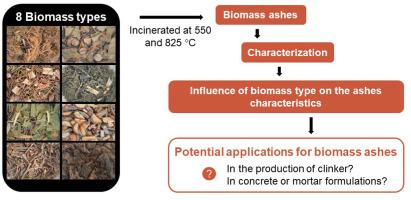Biomass & Bioenergy ( IF 6 ) Pub Date : 2022-09-22 , DOI: 10.1016/j.biombioe.2022.106598 Marinélia N. Capela , David M. Tobaldi , Maria P. Seabra , Luís A.C. Tarelho , João A. Labrincha

|
In the boilers of pulp mills the fuel blends used vary because they are essentially composed of residual forest biomass. Consequently, the physical-chemical properties of the produced ash streams can exhibit high temporal variability, making their proper management and recycling difficult. This study aims to characterize the ash from the incineration of biomass samples used as fuel in order to understand its influence on the properties of the generated ash fluxes. This can anticipate suitable blending procedures that minimize the variability of the ash characteristics. For this purpose, typical biomass samples (eucalyptus bark, treetops and knots, pine treetops, silver wattle, Sydney golden wattle, white poplar, and grey willow) were incinerated (at 550 and 825 °C) and the resulting ashes were characterized. The thermal behavior of the biomass was evaluated by TG/DTA and the generated ash content was determined. The particle size distribution (laser diffraction), morphology (SEM), mineralogy (XRD), and chemical composition (XRF) were other evaluated properties. From the results obtained it is concluded that the ashes cannot be used as raw materials for clinker production. However, they can be used in concrete and mortar formulations, as a cement substitute or as filler. The maximum incorporation amount depends on the type of biomass used, ranging from 54 wt% for pine treetops to 100 wt% for eucalyptus bark. This knowledge is fundamental to understand how to optimize the biomass blends used in industrial combustion systems to obtain ashes with suitable properties to be used as secondary raw materials in building materials formulations.
中文翻译:

纸浆和造纸工业燃烧系统中使用的不同生物质燃料产生的灰烬的特征及其回收利用
在纸浆厂的锅炉中,使用的燃料混合物各不相同,因为它们基本上由残留的森林生物质组成。因此,产生的灰流的物理化学性质可能会表现出很大的时间变化,使其难以妥善管理和回收。本研究旨在表征用作燃料的生物质样品焚烧产生的灰烬,以了解其对产生的灰烬通量特性的影响。这可以预期使灰分特性的可变性最小化的合适的混合程序。为此,典型的生物质样品(桉树树皮、树梢和树节、松树梢、银荆树、悉尼金荆树、白杨树和灰柳树)被焚烧(在 550 和 825 °C 下)并对产生的灰烬进行表征。通过 TG/DTA 评估生物质的热行为并确定产生的灰分含量。粒度分布(激光衍射)、形态学(SEM)、矿物学(XRD)和化学成分(XRF)是其他评估特性。从获得的结果可以得出结论,灰烬不能用作熟料生产的原料。然而,它们可用于混凝土和砂浆配方,作为水泥替代品或填料。最大掺入量取决于所使用的生物质类型,范围从松树梢的 54 wt% 到桉树皮的 100 wt%。这些知识对于了解如何优化工业燃烧系统中使用的生物质混合物以获得具有合适特性的灰烬以用作建筑材料配方中的二次原料至关重要。


























 京公网安备 11010802027423号
京公网安备 11010802027423号